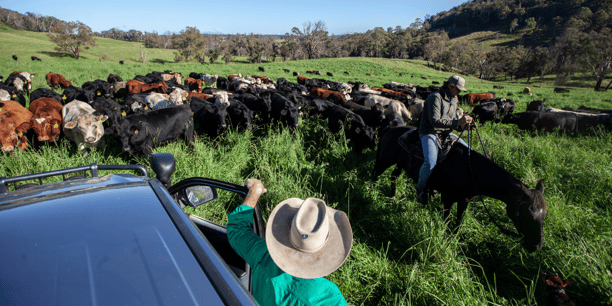We have seen significant income and impact generated in Australia both in voluntary carbon markets and under the Australian ACCU Scheme. As impressive as these results are, they also appear to be in contrast with carbon trends elsewhere in the world.

Wilmot Cattle Co.
Two years ago, early-adopter Wilmot Cattle Company sold $500,000 of carbon credits to Microsoft in a private transaction.
More recently, two farms, Moora Plains and Rexton, generated over 150k Australian Carbon Credit Units (ACCUs).
But given the changing trends, we’ve been wondering: what might happen if Australia continues to drift away from the global carbon consensus?
The tectonic plates are shifting
Globally, we are seeing clear signs that nature-based solutions are under scrutiny in terms of the durability of carbon removals.
And emerging standards such as SBTi (Science Based Targets), and specifically their FLAG guidance, are clear that offsets are not a valid method to achieve science-based emissions targets – organisations must focus on reducing their own emissions.
Global food giant Nestle, for example, recently made their view on offsets clear:
Our net zero roadmap does not rely on offsets. We focus on GHG emissions reductions and removals within our value chain to reach our net zero ambition.
It seems the tectonic plates are shifting away from recognition via offsets.
Don’t sell them, you are going to need them
Even within Australia, there are strongly divergent views about the risks faced by farmers in selling offsets. Prof. Richard Eckard, for example, has expressed concerns:
The agricultural sector has its own targets to meet by 2030, and therefore needs to keep its carbon in-house to offset its own emissions if necessary throughout the supply chain. While some people might say we have a surplus to sell, we simply don’t.
In other words, as target setting by downstream organisations places increasing pressure on upstream suppliers, Australian farmers will need to be able to supply farm-gate outputs that are net-zero emissions.
The challenge is that, while there are good examples of progressive producers like Delatite Station who are focusing their carbon programs on insetting, it’s unclear how long premiums will survive. As corporate target dates get closer, emissions intensity may transition to being a market access factor.
For Australian farmers, building carbon stocks on-farm may well make sense. But expecting payment as an offset may not.
Is soil carbon a risky business?
There are many reasons why farmers benefit from building carbon stocks, especially in soil. For example, there is an abundance of evidence that increasing soil organic carbon (SOC) delivers productivity and resilience windfalls.
But building soil carbon solely to create carbon credits may be a far riskier undertaking. In addition to the market access risks discussed above, there are also risks around the durability of soil-based removals. Despite good practices, it is possible that other factors will cause soil carbon levels to drop.
The range of soil types suitable for significant growth in SOC may also be limited. Recent research indicates that there is very wide variability in the success of programs seeking to build SOC, and it may only be possible to sequester significant carbon in severely depleted soils. This risks amplifying concerns of farmers that carbon schemes may benefit “laggards” rather than early adopters.
Should we be separating recognition from outcomes?
One factor that might be contributing to the divergence is that today, most systems directly connect outcome recognition and reward. An ERF method needs to be used to generate ACCUs, which can then only be sold under the ERF scheme.
If there was more separation and partitioning between practice change, measurement, and verification, it might provide farmers greater flexibility to decide how to be rewarded, rather than forcing them to decide up front.
So what .. for the future of carbon farming
As the Australian narrative appears to be diverging from other narratives playing out globally, we’re left wondering what this might mean for the future of carbon offset strategies both within and beyond Australia’s borders.
Here are a few possible future scenarios;
We go it alone.
Australian farmers enjoy a vibrant, functional carbon offset market for decades to come, representing a legitimate second income stream that is (at least partially) uncorrelated to their current value chain. Australia may operate in a largely sovereign offset market, backed by initiatives like the Safeguard Mechanism, that’s largely untethered to international standards like SBTi and FLAG.
Split the (natural) difference
Australian natural resources involved in decarbonization efforts bifurcate into those largely supporting offsets and those aligned to decarbonized agrifood value chains. Marginally productive land is turned over to vegetation and other rewilding-style programs that focus exclusively on ecosystem service markets for economic viability. Productive land remains focussed on producing food and fiber, and ensuring that those outputs are as low-emissions as possible to guarantee ongoing market access, domestically and internationally.
More ripple than wave
The ACCU Scheme peaks and then declines as global progress toward science-based targets dries up demand for offsets and results in decarbonisation efforts being squarely focussed on scope 3 emissions reductions along agrifood value chains.
In pursuit of a sustainable future
While instructive to separate them out, it’s probable that the future will be a combination of all three scenarios. What’s less clear is what signal Australia is sending with too great a focus on soil carbon sold as offsets.
There is little doubt that the ERF methods are rigorous and produce quality outcomes, and that projects like Rexton/Moora Plains deserve recognition and reward.
But it’s also possible that too much focus on offsetting will appear tone deaf to our international trading partners as they strive to meet ambitious, science-based emissions reduction targets.
It’s also clear that carbon farming and emission reduction strategies need to be as dynamic and adaptable as the landscapes they seek to preserve.
Australian farmers, along with the broader agriculture sector, will be vital players in this unfolding drama. As they face the challenge of aligning their practices with both domestic policies and the expectations of a global market, they have the potential to shape the path that Australia will take.
Ultimately, the pursuit of a sustainable future requires not just a commitment to reducing the immediate impact of harmful emissions, but also a broader vision that includes the long-term health of the land, the prosperity of those who work it, and the viability of the industries it supports.
With its vast potential for carbon sequestration, Australia has the opportunity to lead the way in transforming not just individual practices but an entire system of values surrounding agriculture, carbon dioxide removal, and our collective carbon future.
J Matthew Pryor Co-Founder & Managing Partner of Tenacious Ventures. He is a serial entrepreneur and agtech pioneer with extensive experience in technology & agriculture in Australia and the USA. His experience spans creation, scaling, and exit on both sides of the table.
 Results
Results
